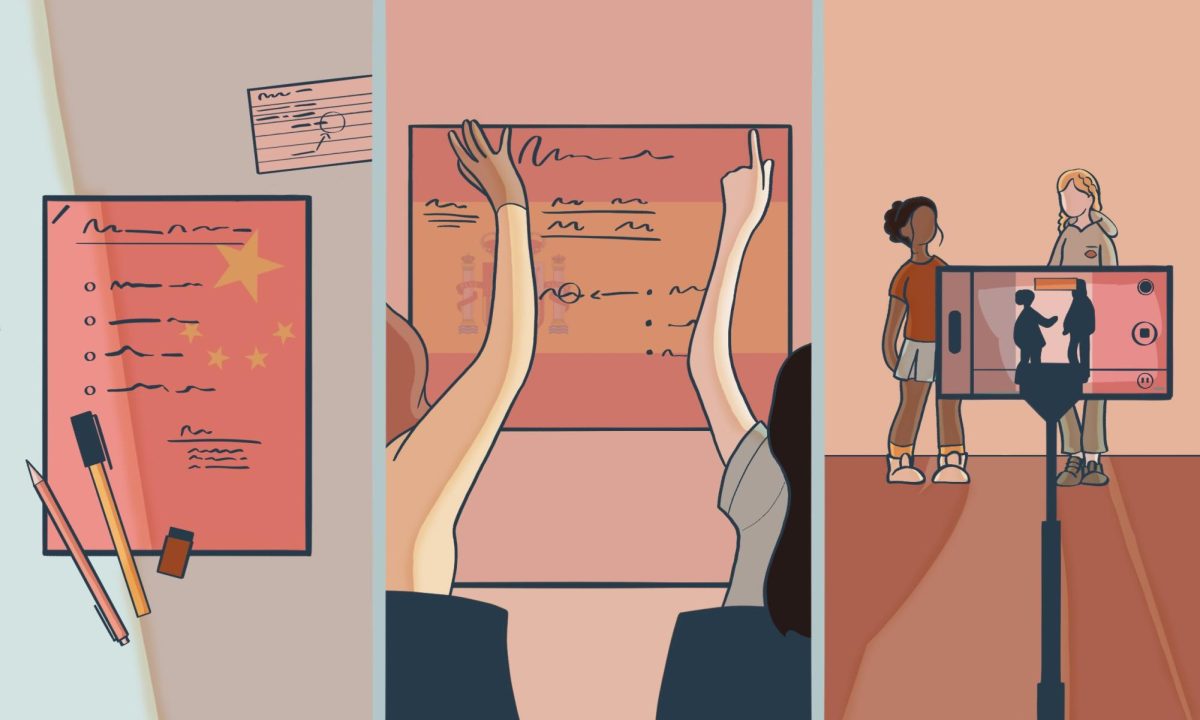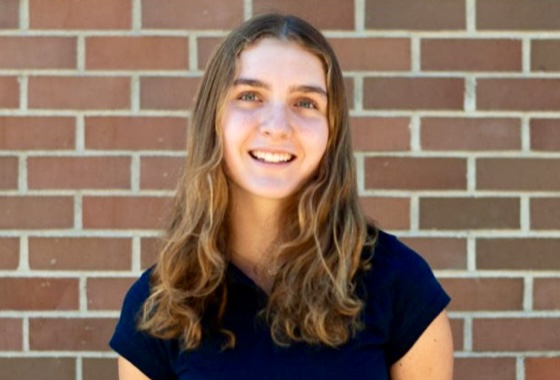Languages are difficult to maintain, even for kids who have grown up with that language. What becomes challenging is going to school and having to maintain that non-English language while high school makes English complex and consequently diverts a bilingual student away from their other native language. Michelle Huang ’27, Nancy Morales-Guzman ’27, and Noor Maraqa ’26 share how after growing up with their respective languages, alongside English, they have utilized Castilleja’s language program to further their cultural understandings. Their perspectives shed light on the strengths and weaknesses of the language program as well.
One of the benefits for these students was learning the more academic version of their languages. Huang said that she used to only take French, but this year, she chose to double-up by taking French IV and Chinese IV.
“My family and I felt like it was very important for me to learn more about the language in an academic setting because currently my learning just comes from speaking at home and watching TV shows,” Huang said.
She said it was her intention to enroll in Chinese from the start, but since she was too advanced for Chinese 1A, she went through the French program until the Chinese level was complex enough. Huang said she could read and type Chinese.
“In daily speech, it’s a lot more casual, and whenever I needed to write long blocks of text, it would just jump from one thought to another. This class gave me a lot of insight into academic writing, structuring, writing strategies in Chinese and also taught me a lot more vocab that I never think to use in my daily life because there isn’t really a need for it,” Huang said.
Huang was looking to take AT Chinese this year, and while her placement test score would have placed her into AT, Huang said Chinese teacher Hwai Lin explained she wasn’t going to put [Huang] in AT because of bad experiences from previous sophomores that went into AT.
“My presence in the class is not so much about vocabulary or speaking capabilities. It’s more about learning the structure and the nuances behind the languages and also obviously to be able to take the AP exam,” Huang said.
Morales-Guzman learned Spanish by listening to her grandparents, but she did not learn any grammar. Her parents made her take Spanish at Castilleja, and she is currently at level IV. When offered the chance to switch languages, Morales-Guzman chose to stay because of the program’s focus on grammar. While she said she doesn’t correct her grandparents’ Spanish because that would be rude, she does correct her classmates with reading and remembering vocabulary.
For the first seven or eight years of Maraqa’s life, she was raised by her Chinese-speaking grandparents and great-aunt on her mom’s side and attended a Chinese preschool. Maraqa spoke English only with her parents, but because her mother’s side of the family is specifically from Shanghai, they speak Shanghainese, another dialect of Chinese. Shanghainese conflicted with the Mandarin taught at Maraqa’s Chinese preschool.
“Even though I learned Mandarin, there were some words that I would say in Shanghainese and there were times I had to learn what proper Chinese was versus the Chinese I spoke,” Maraqa said. Additionally, Maraqa used to take Arabic in homage to her father’s roots, but she used to confuse it with Chinese as well.
She was a fluent speaker before coming to Castilleja, but her writing and reading were “way more rudimentary,” as Maraqa put it. “There have been a lot of moments where we’re learning things in class, and I know how to say something, but I just don’t know how to read or write them. So I think that was definitely one of the things that I wanted a more well-rounded knowledge of.”
Keeping in mind the objective of learning an academic or professional language, the three students offered their insight on how Castilleja is meeting this goal.
“The kind of Spanish they teach here…it’s preparing you for the kind of Spanish that professionals speak. But what I see is that they want us to apply it to native speakers – people who aren’t professionals, they’re just regular, everyday people. The Spanish they teach here is not really the same,” Morales-Guzman said.
She explained that while they practice listening to natives speaking Spanish, the auditory exercises are typically slow and don’t authentically capture how natives talk. “So, I feel like if people watched interviews of actual native speakers – like maybe watching the news or listening to the radio, that would help teach them Spanish that is used,” Morales-Guzman said. This was her experience in Spanish IV, but she believed that Spanish III did a good job of having videos for authentic dialogue and listening practice.
“I feel like if they changed the curriculum a little bit, then it could also be beneficial for people who aren’t native speakers,” Morales-Guzman said.
Despite speaking Chinese for the majority of her childhood, Maraqa said she was surprised by how much Castilleja’s Chinese program taught her. “It was a lot harder than I thought it was going to be. I was expecting to know almost all of the words that we learned.”
Maraqa feels that the Chinese program is really strong. “Especially because we only have two Chinese teachers, they communicate really well with each other and the courses build upon each other,” she said.
However, Maraqa said that after middle school, there is no handwriting practice. “Obviously, I love not having to handwrite because it’s a lot easier, but I do think it’s a good skill to have and we just never even practice it,” Maraqa said.
It is a struggle to create a program that balances the needs of native and non-native language learners because of the need to teach colloquial and academic versions of the languages. It’s also difficult for these native speakers to balance their languages with English alongside any other language that they want to learn.
When asked about their language goals, this is what each of the students shared:
Huang said she will take AT French and AT Chinese next year.
Maraqa said she wants to continue learning Arabic in college. “It’s so much easier to understand cultural things when you also have that language background. I definitely want that, but I also don’t want to lose my Chinese.”
Lastly, Morales-Guzman said that she would want to take Portuguese or Italian since they are similar to Spanish, and therefore, they would be more natural for her.
These native speakers have their own struggles with balance but offer insight to their peers.
“Even though the points that I’m trying to learn from are a bit different from my peers, I’m still learning a lot, and I think that’s just what matters,” Huang said.
There is still a lot to learn, and these insights can help tailor language programs for the benefit of both native and non-native speakers.



